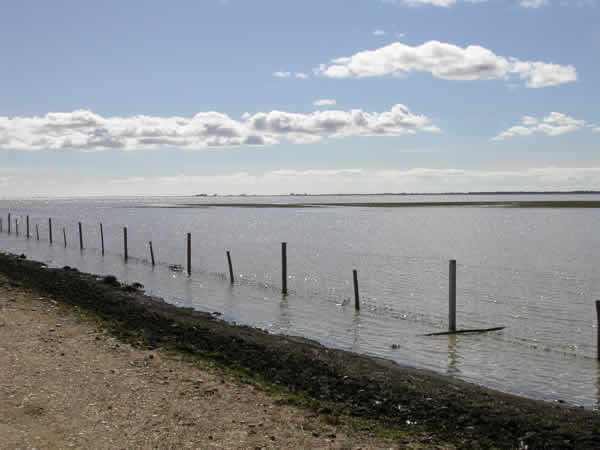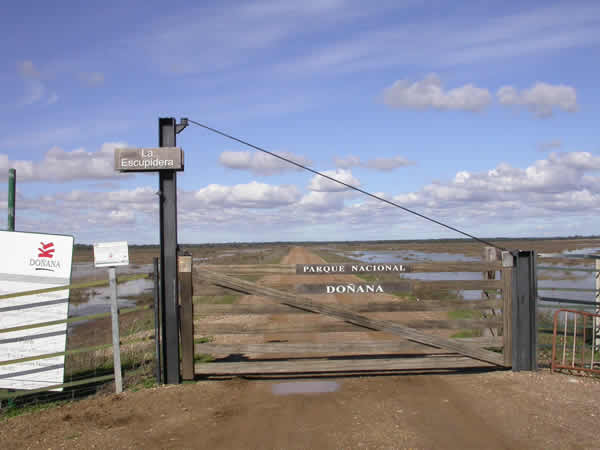Visit your favourite destinations |
| A Report from birdtours.co.uk |
Doñana, February 17th 2010,
Last Thursday Robert and Nicoleta, a German couple who, according to their words, winter in Andalusia, wanted to see the Imperial Eagle, well especially Robert, who was the real raptor fan. As always in these cases, I warned them that I could not guarantee the sighting, but if the rainy weather gave us a break we would have good chances. It's eagles mating season so they spend much time in the air performing their nuptial flights so that opportunities to observe them are better.
We met at Venta del Cruce, the day was sunny and promising. We headed south, passing first by the colony of storks in the Dehesa de Abajo where we observed a distant flock of Flamingos, and then continued to link with the road along Entremuros. As we passed the access track to Casa Neves we found the pair of Purple Herons that has chosen this corner of the reed beds for the winter, a rare observation in this time of year.
The level of the water along the channelling of the Rio Guadiamar is still very high, though both Don Simón Ford and Los Vaqueros are open. Along the track that goes along the right banks we saw numerous Marsh Harriers, Grey Herons, Little Egrets, Corn Buntings, Chiffchaffs, Stonechats, flocks of Common Coots, Swallows, Spanish Sparrows, some Common Pochards, Great Egrets, Buzards, Common Kestrels, Hen Harriers, Black Redstarts; but we don't stop for the first time until we came across a Caspian Tern , whose presence so far from the sea is rather unusual.
We continued to Casa de Bombas where we turned right towards Caño Guadiamar. In the semi-natural marshes we passed by saw several groups of Cranes and soon after, in the fields of cereal before the spot called Two Bridges, huge flocks of several thousand Greylag Geese grazing. It won't take long before they all leave us to go back to their breeding areas in the north.
Crossed the two bridges we saw huge flocks of Calandra and Skylarks flying over the open fields on both sides of the gravel track. The first will stay with us to breed in our marsh, the second will leave to seek cooler areas where they breed. When we reached the Cano Guadiamar, the original course of the river of the same name, the first thing we noticed was the large number of Coots wide spread across the yellow water layer covering the drain. We were entering the Imperial Eagle territory, specially that of the pair that breeds in the woods near Palacio del Rey, near the northern edge of the marshes. The fences that run along the Caño are also regular perching places of eagles and other raptors.

Common and Red-knobbed Coots, Great Crested Grebe, Little Grebe, Great-crested and Common Pochard, Shoveler and Pintail, all showing an interest to cut with fine scissors the ribbon to officially open the breeding season, the funniest time of the year. Coots, fighting in pairs or trios or even quartets, one do not really know who is against who, keeping their bodies out of water in order to use their strong legs as an offensive weapon. Great Crested Grebes, with their long necks stretched out, resemble fine gentlemen of manicured beard and messy hair to the wind, and behave as such, restricting themselves to their civilized chats in pairs, although they seem to disagree with every argument used by their counterparts. The small Little Grebe in contrary behave like court jesters, enlivening the morning with their infectious laughter. Everyone to his own interest showing no interest by what goes on around them while simultaneously keeping an eye alert to the comings and goings of the Marsh Harrier. In the tamarisks at the edge of the track Chiffchaffs, Stonechats and Robins don't have to worry about harriers, but to find enough food on this cold winter day. A couple of the more and more scarce every year Reed Buntings got more alarmed by us and flew away to a bush in the middle of the channel.
Sometimes a coot appeared not to follow the usual behaviour, seemed to forget that what is required when a human approaches is a crazy race over the water rushing into the nearest reed bed. Tweaking a bit of light we could see that his behaviour was not only different, their appearance also differed slightly from the usual, in silhouette dark included two small bumps on his forehead that clarified our doubts at once, it was one of our Red-knobbed Coot. They used to be called Horned Coot in Spanish, recently they changed the name to Moorish Coot. Obviously it's not that these coots have horns, but in the mating season the red bumps can increase in size as they can get to look like little horns. There are other minor differences between our two species of coots, but this is certainly the clearest in the spring. We could see up to 3 of them, with the same conduct committed, two of them with horns that really distorted in an obvious way her figure, and another with smaller bumps. The confident character is not a typical feature of this species at all, but instead they are usually more shy and discreet than their more common relative. The explanation of this atypical behaviour of our 3 coots lies in the fact that more than likely come from the breeding program and reintroduction of the species in which the near Natural Reserve of Cañada de los Pájaros is involved. And in relation to the size of the bumps, in males they tend to be larger, but what really determines its size, rather than the sex of the individual, according to the expert opinion of Maribel Adrian from Cañada de los Pájaros, is the hormonal load accumulated in reproductive phase. But there is something much more helpful to the identification of sexes in the species, this is their calls, the female has a simple and profound call that sounds like an U blown into a jug. The sounds emitted by the male are more varied and similar to those of the Common Coot.
We left behind the Caño Guadiamar, with their yellow waters, where our quest of the Imperial Eagle was unsuccessful, and we moved into the Hinojos Marshes with renewed hopes. The ochre waters of the marsh curled under the strong winds, dead animals here and there, swollen bellies of horses and cows pushed towards edges and fences, the effects of the flood affect everyone. Hares take refuge in the margins of the tracks and Lesser Short-toed Larks, Corn Buntings, Sparrows, Skylarks and White Wagtails, with a couple of Yellow Wagtail somewhat out of season, also find on the track a dry place to feed and rest, there they feel Kestrel harassment and a Merlin. The mixed flocks strive to make way to our car a few yards ahead of us. Sighted small groups of Cranes, Spoonbills, Egrets and Geese feeding among the flooded pickeweeds. It starts to rain again as I write. Storms usually enter Spain from the northwest, first affecting northern communities, this is the norm, this year are coming from the southwest, flooding fields and towns in the Canary Islands and Andalusia. Nobody wants more water and no one needs it, but continues to fall without mercy . Red Kites and Ravens overfly the marshes in search of victims displaced from their secure environment by water or dam and swept away by it. The first daisies, small yet, as not daring to open under this winter leaden skies, scattered along the gutters. After a few false alarms we continued scanning the skies, today finally blue and decorated by round white clouds, looking for our main objective.

We arrived at Cancela de la Escupidera and made a stop to explore the near forest edges and the western edge of the marshes, appropriate venues for our imperial eagle. It's Already noon and we keep stressing our eyes with the difficult search. A large flock of Pintail flew over the road and following them to the wetlands found a small group of 6 Curlew and several Shelduck resting in shallow water. A large flock of about 500 Avocets raised in the distance and several hundred Black-tailed Godwits manoeuvred over the flooded meadows. To the southeast, over the woods near Palacio del Rey, we saw two large silhouettes that rose the alarms. But they are just two Griffon Vultures; but if conditions are appropriate for them they are also good for our large eagles. A couple of early Short-toed Eagles also took our attention. Small groups of Fallow Deer looking for reliable passage between the flood plains and Black-headed Gulls for food in the water rushing down from nearby forests. Mallards and Shoveler in areas of the marshes where most of them had never set foot before.
We kept moving north until we reached the edge of the marshes, completely flooded this year. From there, finally, in the distance, flying low over the oaks of Matasgordas we found a large raptor that turned out to be an adult Spanish Imperial Eagle. We watched it for about 5 minutes before losing it in the distance. I little while later another individual appeared, lighter in colour, probably a second year bird, flying higher on the marsh. For Robert that meant already a great success, I still hoped to get a better view of the animal. Back at Cancela de la Escupidera, accompanied and followed by the fate saw a couple of adults in courtship flight over eucalypts beside the marsh western edge. The exhibition lasted for about half an hour, during which Robert did not separate his eyes off his telescope and binoculars. He cheered every dive and every trill of the eagles showing his satisfaction. There really are few things more spectacular in Doñana than this scene; when the 2 eagles came to just under 1 km from us the show reached its climax, and Robert too. Now we were both satisfied with the achievements obtained.
Why not send us a report, or an update to one of your current reports?